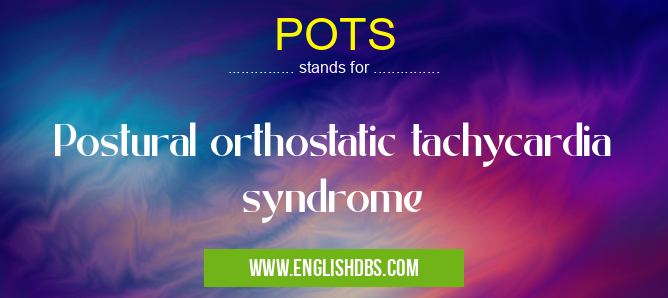What does POTS mean in THERAPY
POTS stands for Postural Orthostatic Tachycardia Syndrome. It is a medical condition characterized by an abnormally rapid increase in heart rate upon standing up from a lying or sitting position. This can cause a range of symptoms, including lightheadedness, dizziness, and fainting.

POTS meaning in Therapy in Medical
POTS mostly used in an acronym Therapy in Category Medical that means Postural orthostatic tachycardia syndrome
Shorthand: POTS,
Full Form: Postural orthostatic tachycardia syndrome
For more information of "Postural orthostatic tachycardia syndrome", see the section below.
What causes POTS?
The exact cause of POTS is unknown, but it is believed to be related to a problem with the autonomic nervous system, which controls the body's involuntary functions, such as heart rate and blood pressure. In people with POTS, the autonomic nervous system does not respond appropriately to changes in body position, causing the heart rate to increase too quickly when standing up.
What are the symptoms of POTS?
The symptoms of POTS can vary from person to person, but they typically include:
- Lightheadedness
- Dizziness
- Fainting
- Fast heart rate
- Palpitations
- Chest pain
- Shortness of breath
- Nausea
- Vomiting
- Fatigue
- Blurred vision
- Headaches
How is POTS diagnosed?
POTS is diagnosed based on a physical exam and a Tilt Table Test. The tilt table test involves lying on a table that is tilted to a nearly upright position. The test measures heart rate and blood pressure before, during, and after the table is tilted. If the heart rate increases by 30 beats per minute or more within 10 minutes of standing, the test is considered positive for POTS.
How is POTS treated?
There is no cure for POTS, but there are treatments that can help to manage the symptoms. These treatments may include:
- Medications to slow the heart rate
- lifestyle changes, such as increasing salt and fluid intake and avoiding caffeine and alcohol
- Exercise
- Physical therapy
- Cognitive-behavioral therapy
Essential Questions and Answers on Postural orthostatic tachycardia syndrome in "MEDICAL»THERAPY"
What is POTS?
Postural orthostatic tachycardia syndrome (POTS) is a condition that causes a rapid heart rate increase (tachycardia) when standing up from a sitting or lying position. This can lead to symptoms such as lightheadedness, dizziness, fatigue, and fainting.
What causes POTS?
The exact cause of POTS is unknown, but it is thought to be related to a problem with the autonomic nervous system, which controls blood pressure and heart rate. Some people develop POTS after a viral infection, surgery, or trauma.
How is POTS diagnosed?
POTS is diagnosed based on a patient's symptoms and a physical exam. A doctor may also order tests such as a tilt table test or an electrocardiogram (ECG) to confirm the diagnosis.
How is POTS treated?
Treatment for POTS may include lifestyle changes, medications, and non-drug therapies. Lifestyle changes may include increasing fluid intake, wearing compression stockings, and avoiding sudden changes in position. Medications may include beta-blockers or calcium channel blockers to help control the heart rate. Non-drug therapies may include physical therapy or acupuncture.
Final Words: POTS is a chronic condition that can significantly impact a person's quality of life. However, with proper treatment, most people with POTS can manage their symptoms and live full and active lives.
